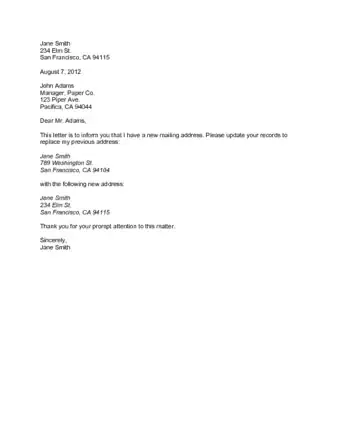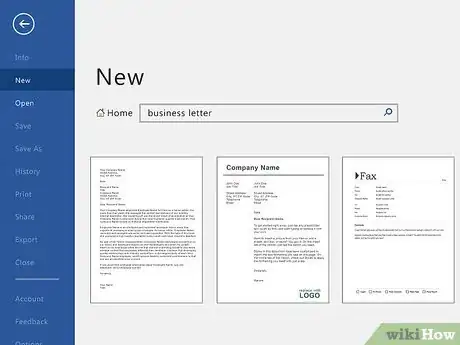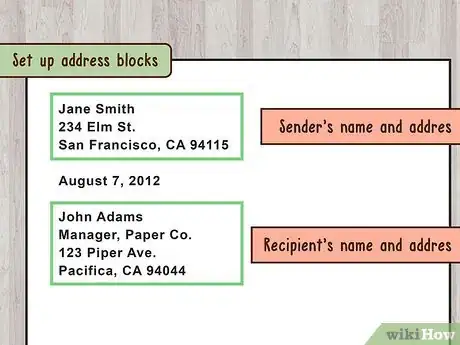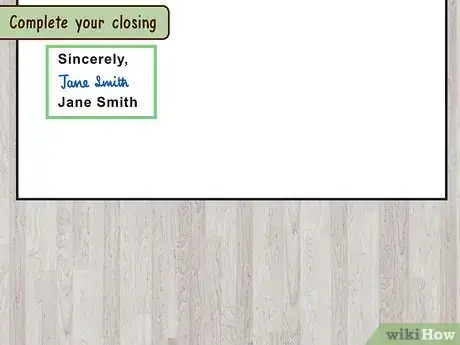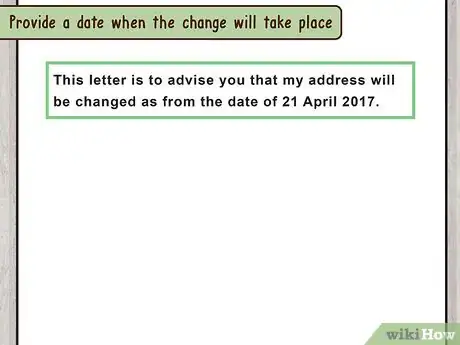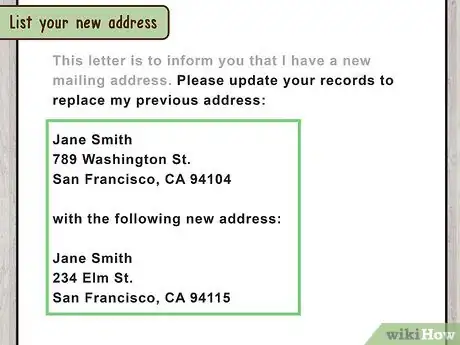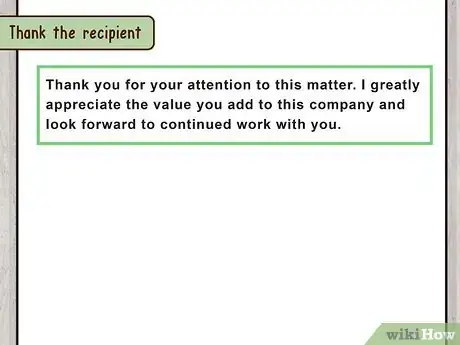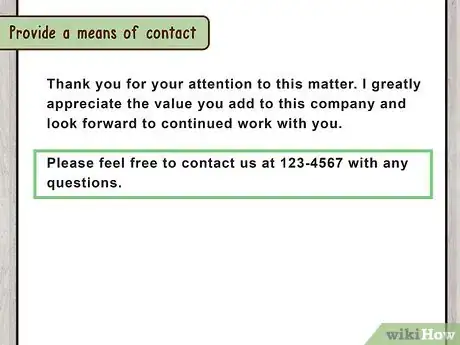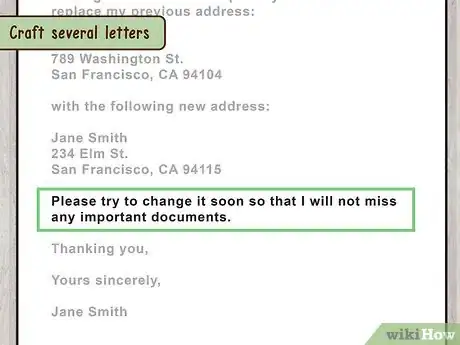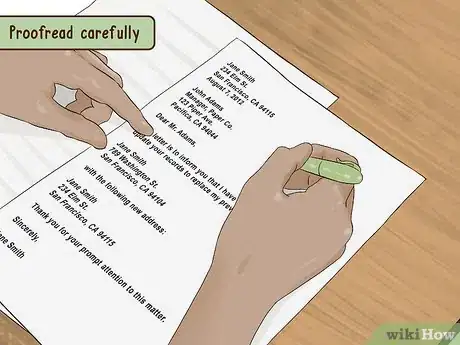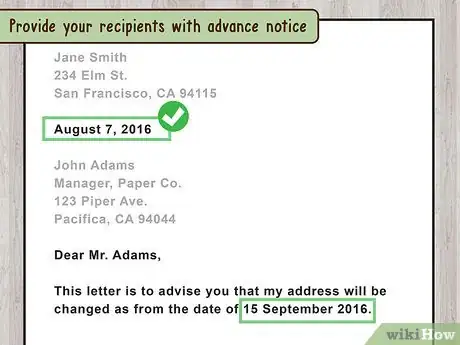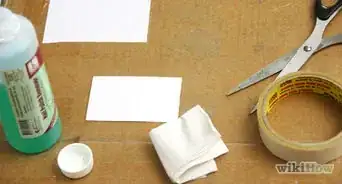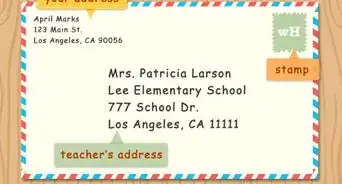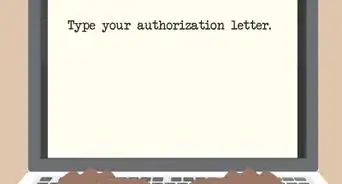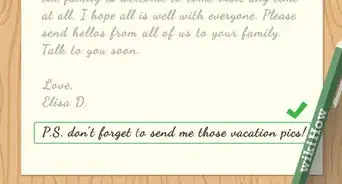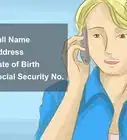This article was co-authored by wikiHow staff writer, Jennifer Mueller, JD. Jennifer Mueller is a wikiHow Content Creator. She specializes in reviewing, fact-checking, and evaluating wikiHow's content to ensure thoroughness and accuracy. Jennifer holds a JD from Indiana University Maurer School of Law in 2006.
This article has been viewed 1,450,448 times.
Learn more...
Whether you're moving yourself and your family or relocating your business, you may want to write a formal letter for change of address so all of your contacts have your new address. Particularly if you're relocating your business or writing to business contacts, you want to maintain a particular format. For friends and family members, you may want to send a handwritten postcard rather than using a formal letter.[1]
Steps
Sample Change of Address Letters
Formatting Your Letter
-
1Look for a business letter template. If you're typing your letter on your computer,check for templates in the word processing application you're using.Most word processing apps have a number of different letter templates.[2]
- Use a basic business letter template that has blocks for the date, your address, and the address of the recipient.
- If you have business or personal letterhead that you plan to use to print your letter, make sure the template you use has room to accommodate that.
-
2Create a mailing list. The easiest thing to do, especially if you are sending your letter to a long list of recipients, is to create a mailing list on a spreadsheet. You can then use the "mail merge" function on your word processing app to populate the fields on your form letter.[3]
Mailing List Checklist
First and last name of the recipient
Complete mailing address
Any other contact information i.e. phone number, email address, fax
Proofread your mailing list carefully to make sure you haven't made any typos in entering anyone's name or address.Advertisement -
3Set up address blocks. The traditional business letter format includes a block for your name (or your business's name) and address, as well as the name and address or the recipient. When you enter your address, use your current address, not the one to which you're moving.[4]
- If you're using mail merge, follow the formatting guidelines set forth in your word processing app. Typically this means enclosing in brackets the name of the column from which you want the app to pull data from your spreadsheet, such as "firstname lastname."
-
4Provide a greeting. Your letter template typically includes a double-space after the last line of the last address block, followed by a greeting. It may simply be the person's name followed by a colon, or "Dear" followed by the person's name and a comma.[5]
-
Avoid using the "Dear" greeting if some of your recipients are organizations, other businesses, or government agencies.Typically this greeting is only used for individuals.
-
-
5Complete your closing. When formatting your letter, it's typically best to go ahead and get your closing down first and then draft the body of your letter. The word you use in closing willdepend on your relationship to the recipients.[6]
- If you're writing a letter for change of address of your business, you'll want a more formal closing, such as "sincerely." However, if you have a mix of personal and business contacts, you may want to go with something less formal, such as "thanks."
Drafting Your Letter
-
1Write a brief introduction. Start your letter with a statement to inform the recipient of the letter's purpose. This doesn't have to be long. Typically a single sentence that says something like "This letter is to advise you that my address will be changing soon" will suffice.[7]
- Don't get too wordy with your introduction. You want to keep the letter under a page, so it should be brief and to the point.
- Don't get too wordy with your introduction. You want to keep the letter under a page, so it should be
-
2Provide a date when the change will take place. Along with your introduction, you need to let your recipients knowexactly when they need to start using your new address rather than your current one.[8]
- Make sure you're giving your recipients enough time to receive the letter, update their records, and get any letters out to the proper address.
-
3List your new address. Provide your recipients with the new address they should use for all correspondence with you in the future. Typically it's best to format it the way it should be formatted on the envelope, so it's easy for them to note and copy.[9]
Considerations
Confusion with old address: You can include your old address as well, for example by saying your address has changed from the old address to the new address. However, keep in mind that this might be confusing. Particularly if you have a lot of business or government contacts to whom you're sending the letter, the wrong information could be copied inadvertently by a clerk.
Inform of any other changes: It's also a good idea to let your recipients know what, if any, other contact information will be changing and what will stay the same. This is especially important if they need to get in touch with you during the transition. -
4Include any other relevant information. Depending on the circumstances of your move, there may be other information that your recipients need to know, such as if others also are moving with you, or whether your business will remain open during the move.[10]
Examples of Relevant Information
Business closure: If your business will be closing for a brief period to relocate, you need to inform your recipients of this so they can plan in advance, whether they are customers, suppliers, or other clients.
Moving sale: If you're having a moving sale, this might be a good place to let your recipients know about that as well. -
5Thank the recipient. To close your letter, double space after your last paragraph and write a simple sentence thanking the recipient. If they are a business associate, you may want to also add a note about how you appreciate their business.[11]
- For example, if your business is relocating, you might write "Thank you for your attention to this matter. I greatly appreciate the value you add to this company and look forward to continued work with you."
-
6Provide a means of contact. After you thank the recipient, you may want to provide a phone number or email address the recipient can contact if they have any questions or concerns.[12]
- This is especially important if your business is relocating.You may want to route all questions or concerns about the relocation to a particular phone number or extension, or to a particular email address.
- This is
-
7Craft several letters. Especially if you're relocating your business, you may want to have more than one letter. That way you can tailor one letter specifically to clients or customers, another to business associates, and another to vendors or dealers.[13]
- Consider several letters if you have any relevant information you want to include that only applies to one audience. This way no one is getting any information other than what they need.
Sending Your Letter
-
1Proofread your letter carefully. Before you finalize your letter, check to make sure there are no typos, spelling, or grammatical errors that make your letter look unprofessional or make it difficult to read.[14]
- Check the address in particular and make sure it's correct. You don't want to send your recipients a change of address letter that points them to the wrong address.
-
2Make sure the recipients' information is correct. When you use mail merge for bulk mailings, it can save you a lot of time. But it's also possible thatthere may be errors in how the data is transferred to your letters.[15]
- Check all the fields and make sure they all match and belong to the same recipient. For example, you want to make sure that the name and address of the recipient in the address box matches the name in the greeting.
-
3Print and sign your letters. Once you're satisfied that your letters are formatted correctly and are error free, print them on good stock paper and sign them by hand using blue or black ink. Then they're ready to mail.[16]
-
4Provide your recipients with advance notice. In most cases, you want to make sure your recipients will get their letters withintwo to four weeks prior to the date your change of address takes effect.[17]
- If you have international contacts, you probably want to provide two or three months' advance notice to allow for the time it takes to send mail internationally.
Community Q&A
-
QuestionI get a basic state pension, and have changed addresses. What can I do?
 Community AnswerAll state pension offices can easily handle that. Do an online search to get as close to the correct office as possible and call them, someone there will be able to connect you to the proper office or give you the correct number to call.
Community AnswerAll state pension offices can easily handle that. Do an online search to get as close to the correct office as possible and call them, someone there will be able to connect you to the proper office or give you the correct number to call. -
QuestionHow do I correct my address at work?
 CageyCatTop AnswererTalk to your company's Human Resources department. If there is no HR dept, talk to your immediate supervisor.
CageyCatTop AnswererTalk to your company's Human Resources department. If there is no HR dept, talk to your immediate supervisor.
References
- ↑ http://www.chipmanrelo.com/business-relocation-letter/
- ↑ https://www.rocketlawyer.co.uk/documents-and-forms/change-of-address-notice.rl#
- ↑ https://support.microsoft.com/en-us/help/294683/how-to-use-mail-merge-to-create-form-letters-in-word
- ↑ https://support.microsoft.com/en-us/help/294683/how-to-use-mail-merge-to-create-form-letters-in-word
- ↑ http://www.atyourbusiness.com/changeofaddress.php
- ↑ http://www.atyourbusiness.com/changeofaddress.php
- ↑ http://www.atyourbusiness.com/changeofaddress.php
- ↑ http://www.atyourbusiness.com/changeofaddress.php
- ↑ http://www.atyourbusiness.com/changeofaddress.php
- ↑ http://www.chipmanrelo.com/business-relocation-letter/
- ↑ http://www.chipmanrelo.com/business-relocation-letter/
- ↑ http://www.chipmanrelo.com/business-relocation-letter/
- ↑ http://www.chipmanrelo.com/business-relocation-letter/
- ↑ http://www.chipmanrelo.com/business-relocation-letter/
- ↑ https://support.office.com/en-us/article/Use-mail-merge-to-personalize-letters-for-bulk-mailings-d7686bb1-3077-4af3-926b-8c825e9505a3
- ↑ http://www.chipmanrelo.com/business-relocation-letter/
- ↑ http://www.chipmanrelo.com/business-relocation-letter/
About This Article
If you want to write a letter to alert your contacts that your address is changing, open it with a brief paragraph that tells the recipient why they’re getting the letter. Try writing “This letter is to advise you that my address will be changing soon.” Your letter should be under a page, so avoid being wordy. After your introduction, let the reader know exactly when your address will change and list the new address in the same format it should be used on an envelope. Next, include any extra information they should know. For example, if your business is staying open during the move, let your customers or suppliers know so they can plan in advance. Finally, close the letter by thanking the reader and giving them a phone number or email address where they can contact you. For more tips, like how to format your letter, read on!
